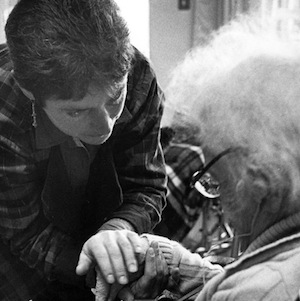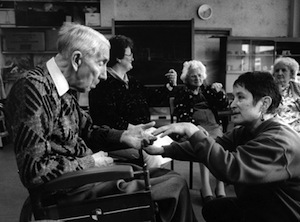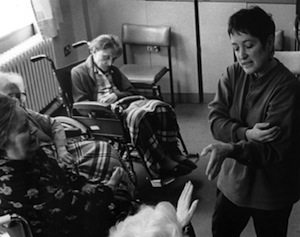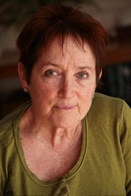The Tai Chi and Chi Kung Forum for Health (UK) provides training for taiji and qigong teachers who wish to teach people who are living in or spending their days in residential homes, hospitals, hostels, prisons, day centres and shelters. The students may have visual impairment, aural impairment, physical difficulties, learning difficulties, mental health problems or be elderly and/or frail, seeking shelter, seeking refuge or for some other reason not able to join a local taiji class. Of course, I can tell only the part of the story which happened to me and there may be many other parallel stories all over Europe.
In the early 1980´s, I read Lawrence Galante´s book Tai Chi, the Supreme Ultimate, in which he mentions having taught an experimental taiji group at Bellevue Psychiatric Hospital in New York City. Since I had grown up nearby and had once visited that hospital myself, this information held a resonance for me. I too thought taijiquan could be beneficial to people with mental illness.
As a young woman I had worked several summers at a day-camp on Long Island for children with learning difficulties and behavioural problems, and I had also worked for a year in a psychiatric hospital in San Francisco. I remember thinking to myself, “If taijiquan is good for me, why wouldn’t it be good for people in a psychiatric hospital too – or any hospital?.”
I left the West Coast of America and moved to Edinburgh, Scotland in 1968 where I found my first taiji teachers, Sandy Cuthbert (Yang Style) and Ian Cameron
(Wudang). Later, in 1980 I came to Manchester and set up my own school, Village Hall Tai Chi. I also began looking into ways of working in hospitals. As far as I knew, taiji classes in hospitals had not yet become available, though I had heard of a few yoga classes.
I wrote to all the hospitals in the area to offer my services as a taiji teacher. Eventually I ended up with a few phone calls from physiotherapists who said that all the physical needs of the patients were already being met. And, anyway, what was taijiquan? They thought they probably didn´t want any. In 1982 taijiquan was still quite new in Europe and it was surrounded with the strange mystique of an oriental esoteric art. I once tried to set up a class in a church hall and was told by the elders of the church that taijiquan represented a threat to Christianity. So I decided to try other avenues. I had been a theatre costume designer and community arts worker in California and then in Edinburgh and I knew something about arts organisations. A group called Shape had an office in Manchester and I approached them about taijiquan in hospitals. Their aim was to offer weekly arts sessions in hospitals, prisons and day centres led by actors, artists and musicians. Shape would fund the first three months of the sessions but the host venue must be prepared to take on the future funding if the sessions proved to be successful. I asked if Shape thought taijiquan could be called an “art and they said”, “of course. It is beautiful, graceful and makes people feel good”. They asked me where I wanted to teach and I told them Withington Hospital Psychiatric Unit, which was my local hospital. After the three months, the hospital took over the cost of the classes through their “education budget”. For several years the class was paid for by the Manchester Department of Education. Those were the “good old days” when adult education in the United Kingdom flourished and there seemed to be enough money for all kinds of interesting projects.
Having had my first class funded by an arts organization and then by a department of education meant that I was not at all connected to health or medical organisations. My classes were seen more as recreational rather than therapeutic. This was a blessing in disguise for two reasons. The first was that no one bothered me. The second was that I then had time to experiment without being observed or having to produce results. Eventually, I realised that teaching on the psychiatric ward was not ideal since the patients were really very ill and were also given high levels of medication. They were not in positions to make positive decisions for themselves and I thought that taijiquan would be more effective further along the recovery road.
Not wanting to lose the “education money” which had been earmarked for the hospital, the staff asked me if there was another department I would like to move to and without hesitation I said “yes, the Geriatric Unit” since I had always had a love for elderly people. The surprise for me, when I went to the ward to discuss the possibility of a new class, was that nearly all the students were in wheelchairs. Some were also deaf, many had had strokes, some were in chronic pain from arthritis and some had dementia. They all lived in the hospital because they required assistance with all basic living activities such as going to the toilet, dressing and eating.
These elderly disabled people became my greatest teachers. We were together for about 8 years, though of course many of them died and others took their places.
Through their goodwill and my desperation (could we really do taijiquan sitting down?)we developed many of the mainconcepts which continued to inform all my subsequent teaching. The first task was to find out what is unique about taijiquan and be sure to include it. I needed to be aware of taiji principles as stated in the taiji classics and attempt to keep the essence of these principles central to the movement work.
Here are the ideas I tried to keep in mind while teaching:
1. Root as low in the body as possible.
2. Employ whole body movement.
3. Let the mind lead the body.
4. Be slow and precise.
5. Shift the weight consciously, whether seated or standing.
6. Celebrate the sensation of movement.
7. Use repetition and pattern.
8. Emphasise same-hand, same-foot and opposite-hand, opposite-foot.
9. Create a movement vocabulary which is carefully directed by the mind.
10. Work with group energy since language will be less effective in a group of hearing impaired people.
11. Introduce touch, self-massage, simple pushing hands.
12. Tell stories and create forms out of the stories. Relate each part of the form to each member of the group (after all, taiji forms are stories of fights – if she does this, I will do that).
13. Use the idea of responding and connecting through games, touch and visual shapes. Use chiffon scarves, foam rubber balls. Pass things, touch things, sing songs, recite poems, put the stories of our lives together.
14. Combine routine with “special events” such as inviting friends, musicians, babies, kittens to attend the group.
15. Drink tea and eat biscuits.
At the time I knew I was venturing well outside what I had learned through my classical taiji training, but I knew that good things were happening. If anyone challenged me (and many people did!) with the question – “yes, but is it really taijiquan if they are all sitting down and don’t do any traditional forms?” I would answer, “it must be taijiquan because that is the only thing I know. If I had been trained as a dancer, it would probably be dance”.
Meanwhile, one of my students in a mainstream class was a social worker in a mental health day centre, and he helped me set up a class in the centre. This was a better setting since the clients (no longer patients) were self-motivated and taking less medication. They were able to make their own choices for their own health programme. We interviewed those interested in attending and Wayne, the social worker, supported the new students by helping them remember when the class met and during the week he helped them by leading some practice. For the first time, a model for good practice was developing.
Over the years I learned a lot about setting up groups and about connecting with the full-time staff who worked within these institutions. When I had a better idea of what I myself was doing, I welcomed consultations with staff and sharing observations about the progress of students/ patients. Eventually taijiquan itself gained wider general recognition as a health practice and I did not have to defend it. But I think back fondly on those early classes when every week it felt like diving off a cliff. Mopping up urine, feeding people, adding tap dance steps to the sitting down warm-ups, including music, seeing an elderly woman sitting in her wheel-chair punching the air with her clenched fists, laughing. Yes, very fondly.
Weekend Courses
For about six years (late 1980´s to early 90´s) I offered a one-weekend course for taijiquan teachers, who wanted to teach students with health needs. I called the courses Sharing the Essence. We met at a lovely little residential centre, Monkton Wyld, in the south of England and I shared my experience and the “solutions” I had come up with so far. Many of the people who attended those early weekend courses went on to begin teaching in hospitals and clinics right away. The field was new and we were all doing our best and welcomed the opportunity to support one another.
Making a Video
In 1994 I decided to make a video to document the special classes I was teaching at that time. The video could be used as a way of introducing the kind of work I was doing. Others could show it to hospital staff as a way of saying “See, this works. People are already doing it”. One of my good friends through taijiquan, Tamsin Carr, was a professional video maker, and we worked together tirelessly on the project. Another wonderfully supportive person (who appears in the film) is a former student and friend who used her practice of taijiquan to help her through a schizophrenic illness. She not only agreed to be interviewed, she also volunteered to interview me. Nearly all the shots of me talking in the final edit are the responses to questions she had asked me. Other classes shown in the video took place in a psycho-geriatric hospital, a day centre for the elderly, a physical rehabilitation centre, and a class at my school called “Tai Chi in Chairs”. The students in this last group also gave filmed interviews about the effects of class on their health.
The First May Gathering
A friend and former student who has a serious physical disability approached me in 1999 about the possibility of him beginning to teach a special class. I was definitely in favour of this proposal, but I felt that he, or any new teacher in this field, might need some further training and ongoing support as well as supervision. I decided to write to everyone on my database who had a tick in the box called “Tai Chi and Special Needs”. The people who responded were then invited to a weekend at my school in Manchester to discuss plans for a new network organisation. Thirty people came. That was the first May Gathering at which the name of the Forum was created. We also wrote our mission statement:
“Our intention is to provide a base for knowledge and skill-sharing, in order to develop good practice and integration in taijiquan and qigong for health and special needs.”
We also defined our two main aims:
1. To formalise a sharing network for those already working in the field of taijiquan/qigong and special needs.
2. To develop and oversee training courses for teachers.
The development of the Forum courses
After three years of running pilot workshops and listening to feedback from participants, the Forum Steering Group launched its two-tier course programme.
All current information and full descriptions of Forum courses and workshops are available on our website. I will however, give you a short overview:
We offer two levels of training, Basic and Plus. The first, Basic, consists of three weekends. Two weekends are workshops and one is the annual May Gathering at which there is the Annual General Meeting of the organisation, invited speakers and presentations from members. This Gathering is open to health and care workers, taijiquan and qigong people or anyone else interested in the Forum. The two workshop weekends are designed to help the experienced player (five years training in taijiquan and/or qigong are usually necessary before attending our courses) move from their classical training to being able to follow principles and adapt movements as necessary.
The first weekend workshop is still called “Sharing the Essence” which is about sharing essence of taiji principles with people with health needs.
The second workshop is called “Taking it Forward”, which helps prepare participants for working within institutions. We offer a lot of information about how to set up classes and how to apply for funding. The students also start leading small groups of fellow students and offer each other feedback.
Instead of focussing solely on taijiquan and principles of movement, they begin to focus on the various client groups that they may teach in the future. Once a person completes these three weekends, they can be listed on the Forum website Tutor Register as a Basic member.
We also offer a series of weekend workshops called Plus workshops. When people complete four of these (in addition to the three Basic weekends) they can be listed as Plus members on the Forum Tutor Register. These Plus workshops go much deeper and begin to specialise in particular areas of interest. For instance, the titles of the Plus workshops currently on offer are: “Biodynamics of Movement”, “Falls Prevention”, “Healing and Chi”, “Pain Management”, “Developing Awareness”,“Tai Chi Principles for Physiotherapists”, “Traditional Chinese Medicine” and “Western Medicine”. Any of these Plus workshops will benefit any taiji or qigong teacher, whoever their students might be. We feel particularly proud of these workshops and hope that teachers from all over Europe will consider attending them. We feel that the area of teacher training (which is currently mostly within individual taijiquan schools) can benefit from these workshops, which are open to players from any school. There is a great sense of sharing and discovery. I will end the story of the origins of the Forum here in order to look at the current most important question. How will we, as taijiquan and qigong players interested in health, integrate our practices into mainstream European Healthcare?
The yin and yang of art and science
Now we face a new challenge – how to fit our yin (or less quantifiable) Oriental art form into the yang (or more quantifiable) Western scientific medical model.
This yin/yang dichotomy is particularly familiar to taiji players. Our current dialogue between taijiquan and the medical profession is similar to other dialogues we have dealt with in the past. As we know, yin/yang comes in many forms.
We are already familiar with: How can we resolve the fact that taijiquan is a spiritually inspired health practice and at the same time a martial art? We European enthusiasts have played out this paradox ever since the 1970´s when the first mysterious movements from China were seen in parks of London, Berlin and Paris. Currently we are looking at ways in which taijiquan can become an integral part of healthcare within established Western medical institutions. This time the balance is between art and science and we mustn’t shy away. There is too much at stake.
In Great Britain, over the past four years, the Tai Chi and Chi Kung Forum for Health has been addressing ways of bridging the gap between these disparate ways of seeing, feeling and experiencing. Through our courses we are attempting to equip taiji teachers who plan to work in hospitals with not only new ways of adapting their classical taijiquan, but with new ways of adjusting their taijiquan “Eastern” perspective. Even the language might change. The word energy might be replaced with the word sensation. The word dantian might change to abdomen. But nothing of the essence need be lost.
Taijiquan and falls prevention
So, is taijiquan good for you? Is taijiquan good for your balance? If you practise taijiquan as an elderly person, are you less likely to fall? The answer is, yes. In fact, almost 50 per cent less likely. What we have always assumed to be true has now been proved clinically by evidence based western research methods and we in the taijiquan world are likely to be dramatically affected by these findings, along with findings in other areas of health.
In the past few years, various medical research studies have been conducted to determine the positive effects of taijiquan on health. The most widely publicised is a study on falls prevention in the elderly by Dr. Steven Wolf, Professor, Department of Rehabilitation Medicine at Emory University in Atlanta, Georgia and also Director of a programme in restorative neurology. The study showed that older people taking part in taiji programmes could reduce their risk of falling by up to 47.5 percent.
Research from American trials has demonstrated the value and cost-effectiveness of targeted fall-prevention programmes and indicated the benefits of integrated balance, coordination, and strength training for the elderly. Dr Wolf said in multi-centre fall prevention trials in the US, elderly people were asked what they were thinking of when they fell. “Repeatedly we were told they didn’t know why they fell – they saw it happening but they didn’t accept liability”, he said. “So perhaps an exercise form such as taijiquan – which is so embedded in visual imagery, which has this natural tie between the movement forms and how they are engaged – can help people understand this very important linkage of how they move, and how they position themselves. That’s the hypothesis.” As a result of these clinical trials, taijiquan could be seen as a “powerful preventative medicine tool” or as an “effective falls intervention” for people as they became older. Movements such as trunk and body rotation were improved. Stability and balance were boosted. Taiji students had a greatly improved sense of control over their own health, building the confidence that led to more independent, and thus more fulfilling lives.
The fact that we as taijiquan and qigong players know these things to be true because we feel them in our bodies is not enough. If we are going to make significant contributions to health policy and practice through the conventional channels, we are more effective if the evidence behind our work is recorded in the appropriate language. In this case, the language of evidence based medical research. I feel this is the greatest cur rent challenge for taijiquan throughout Europe. By integrating our classes into mainstream healthcare services, we have the possibility of reaching thousands of people who are likely to benefit. Our job, as dedicated taiji players, is to provide the highest quality of training for our teachers so they are able to meet this challenge with confidence, skill and credibility.
Final Note
On the news tonight I watched Sonia Ghandi announce that she will turn down the post of Prime Minister, after having won the Indian election. She said that she must listen to “the voice within” and that voice is saying a definite no. It is hard to imagine European politics being determined by “inner voices”. However, I feel confident that it is possible to bring together a respectful connection between intuitive knowledge and scientific enquiry. The balance of art and science (or sensed truth vs. quantifiable fact) is already familiar to us because we have been practising it since we were born – testing our imaginations against our experience, our preferences for what we like against what is good for us, why the sky is blue against why the sky is blue.
This article was orginally written in 2004 for the short-lived European Internal Arts Journal.
Author: Linda Chase Broda
Images: Linda Chase Broda
Linda Chase Broda began tai chi training, originally in Edinburgh, Scotland in 1974 with Sandy Cuthbert (Yang Style) and subsequently with Ian Cameron (Wu Style). In 1980 she moved to Manchester where she set up the Village Hall Tai Chi and started teaching classes in the psychiatric ward of the local Withington Hospital. These initial sessions, and her love of networking, led Linda to create the Tai Chi Health Forum to train tai chi teachers to work with those who had Special Needs.
Linda sadly passed away in April 2011.






